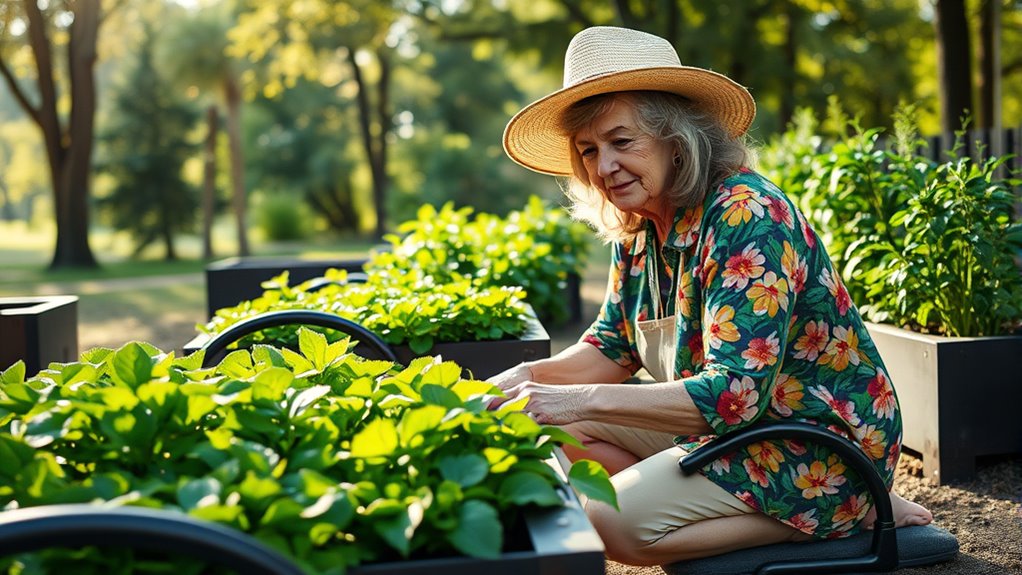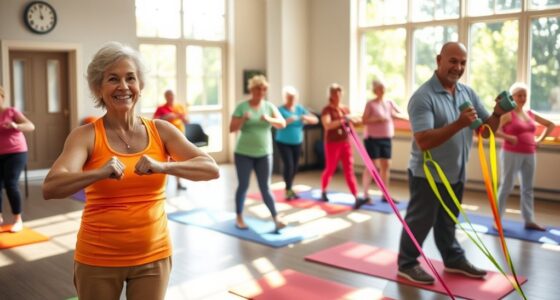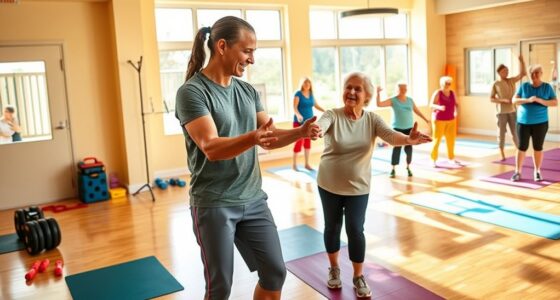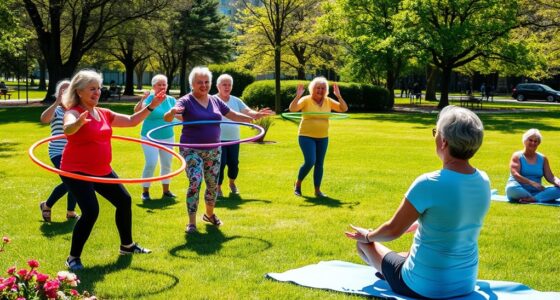To enjoy gardening safely and comfortably, assess your physical abilities and challenges first. Use ergonomic tools like lightweight, long-shafted, and padded-handle options, and modify your garden with raised beds and accessible pathways. Practice proper body mechanics, such as keeping a straight back and supporting joints, while taking regular breaks. Creating cozy work areas and establishing routines help reduce fatigue. Continue exploring these tips to make gardening more enjoyable and sustainable for you.
Key Takeaways
- Assess individual physical abilities and modify garden layouts with raised beds, wide pathways, and accessible tools for easier gardening.
- Select ergonomic tools with lightweight, non-slip handles, longer shafts, and quality blades to reduce effort and strain.
- Practice proper body mechanics, including straight posture, kneeling, and safe lifting techniques to prevent injury.
- Create a comfortable, safe gardening environment using supportive chairs, workbenches at waist height, and organized tool storage.
- Establish routine schedules with breaks and task prioritization to maintain energy, prevent fatigue, and promote long-term gardening enjoyment.
Assessing Your Gardening Needs and Limitations
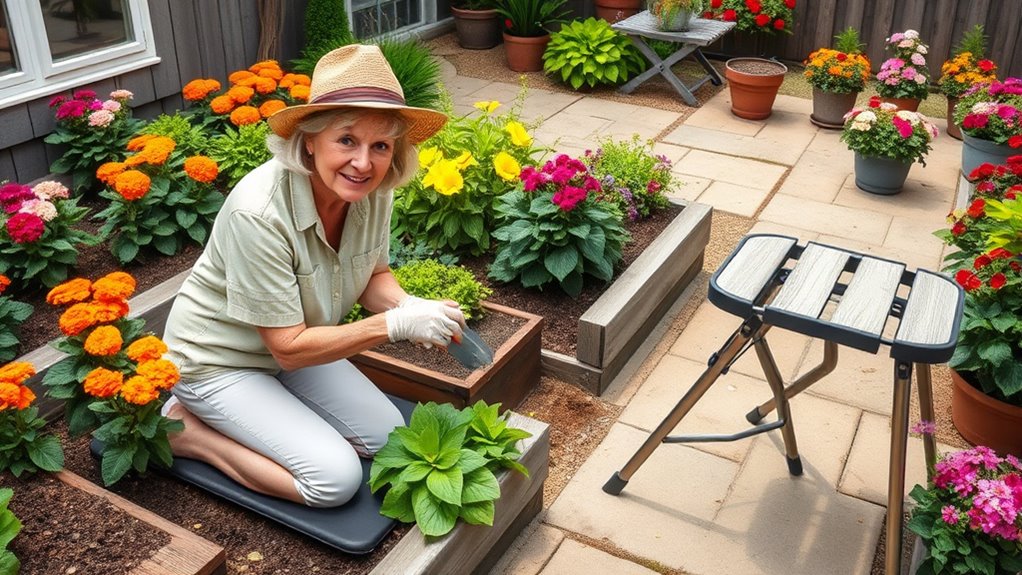
Before you begin designing your garden, it’s important to assess your needs and limitations. Think about how much physical activity you can comfortably handle and which tasks you enjoy or dislike. Consider your mobility, strength, and any health issues that could affect your gardening. Do you prefer planting flowers, growing vegetables, or maintaining a flower bed? Identify specific challenges, like bending or kneeling, and note any tools or adjustments that could make gardening easier. Setting realistic goals helps you create a manageable plan. Take stock of your available space and sunlight exposure. Understanding your capabilities ensures your garden design promotes comfort, safety, and enjoyment, making gardening a relaxing activity rather than a strenuous chore. Additionally, exploring ergonomic gardening tools and techniques can further reduce strain and enhance your gardening experience. Incorporating projector technology into your outdoor space, such as creating a garden theater, can also add enjoyment and entertainment to your gardening area.
Choosing Ergonomic Tools for Comfort and Safety
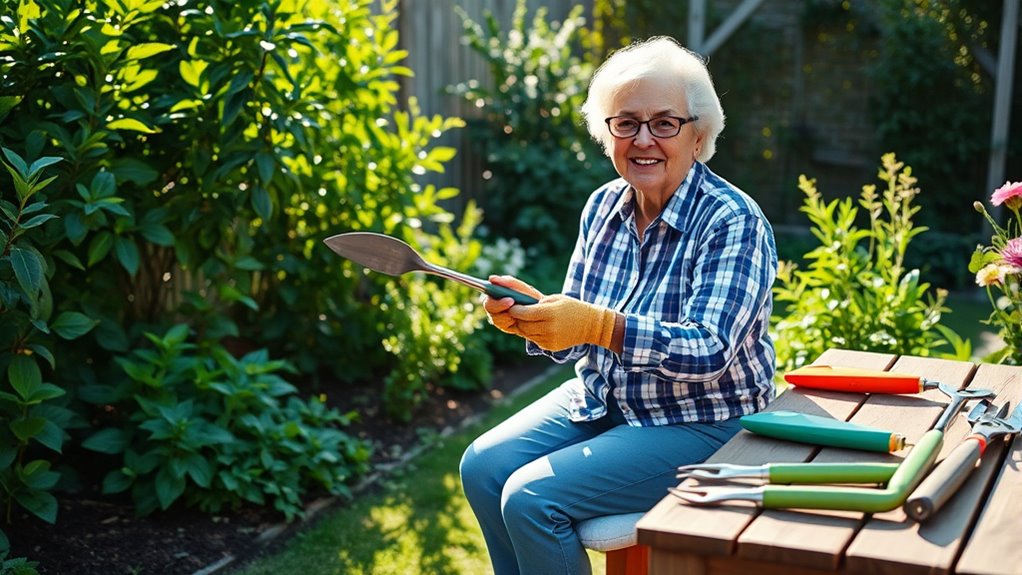
Selecting the right ergonomic gardening tools can substantially reduce strain and prevent injuries, making your gardening experience more enjoyable. Look for tools with lightweight, non-slip handles that fit comfortably in your hand. Tools with longer shafts allow you to work while standing, reducing back and knee pain. Choose tools with padded grips to minimize pressure points. Consider adjustable tools that can be customized to your height and reach. Sharp, quality blades require less force and make tasks easier. Avoid tools with small or awkwardly shaped handles that can cause discomfort. Prioritize tools designed specifically for ergonomic use, and don’t be afraid to test them out before purchasing. Properly chosen tools make gardening safer and more comfortable, encouraging you to enjoy your outdoor space longer. Additionally, being aware of your dog breed’s unique traits can help you select appropriate outdoor activities, ensuring both you and your pet enjoy safe and engaging gardening experiences. Incorporating ergonomic gardening tools can also help reduce the risk of repetitive strain injuries associated with prolonged gardening tasks, and selecting tools with ergonomic features can further enhance comfort. Practicing proper gardening posture while using these tools can further prevent strain and promote long-term health.
Modifying Your Garden Layout for Ease of Access
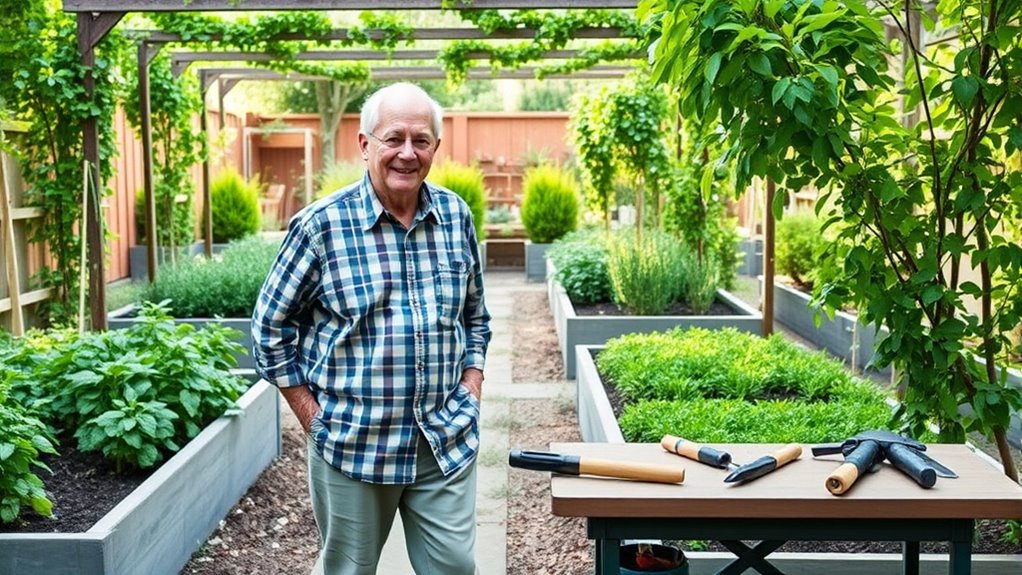
Adjusting your garden layout can make gardening more comfortable and efficient. Consider building raised beds, optimizing pathways, and keeping tools within easy reach. These changes help reduce strain and make your gardening experience more enjoyable. Incorporating natural materials such as wood or stone in your garden design can enhance accessibility and blend seamlessly with your outdoor space. Exploring accessible design principles from hackathons can inspire innovative solutions to improve garden ergonomics.
Raised Bed Design
Have you considered how raised bed design can make gardening more accessible and comfortable? Choosing the right height is essential; aim for 24 to 30 inches to reduce bending and strain. Guarantee the width allows you to reach the center from either side—generally, 3 to 4 feet works well. Use sturdy, smooth materials to prevent splinters and discomfort. Incorporate built-in seating or a ledge along the edge to rest while working. Consider adding adjustable legs or legs with casters for flexibility. Think about drainage and soil depth to promote healthy plants and minimize effort. Properly designed raised beds can transform your gardening experience, making it easier to tend to your plants without unnecessary aches or fatigue.
Pathway Optimization
Ever thought about how your garden’s layout can influence your ease of access and enjoyment? Optimizing pathways makes a big difference. Start by creating wide, smooth paths—at least 36 inches wide—to allow comfortable movement and easy turning. Use non-slip materials like gravel, pavers, or concrete for stability and safety. Keep pathways straight or gently curved to minimize navigation challenges. Remove obstacles such as uneven stones or overgrown plants that can trip you up. Consider placing paths near your most-used areas, like vegetable beds or flower patches, to reduce unnecessary walking. Good pathway design minimizes bending, reaching, and twisting, making gardening less tiring. Ultimately, clear, well-planned pathways help you enjoy your garden more and stay safe while tending to your plants.
Tool Accessibility
Organizing your garden layout to improve tool accessibility can considerably reduce strain and save time. Keep your most-used tools within easy reach by storing them on wall-mounted racks or in clearly labeled, low shelves. Use long-handled tools to minimize bending and stretching, and store them in designated containers near your planting areas. Group similar tools together to streamline your workflow, reducing unnecessary movement. Incorporate raised garden beds to bring your work closer to you, making tools easier to access without bending down. Consider installing a small, portable tool caddy or cart for quick transport between beds. By arranging your tools thoughtfully, you’ll minimize effort and prevent discomfort, making gardening safer and more enjoyable.
Proper Techniques to Minimize Strain and Injury

To prevent strain and injury while gardening, focus on maintaining proper posture and using ergonomic tools. Always lift with your legs, not your back, and avoid twisting your body. Incorporating these techniques helps you work safely and comfortably throughout your gardening tasks. Additionally, selecting ergonomic gardening tools can reduce hand and wrist fatigue, making your gardening experience more enjoyable. Regularly taking breaks and stretching can further prevent muscle strain and promote overall safety. Staying aware of AI safety measures can also help in managing risks associated with advanced gardening technologies. Incorporating adjustable watering pots and choosing tools designed for comfort can further enhance your gardening safety and efficiency. Being mindful of Halloween safety tips, especially during festive activities, ensures a secure and enjoyable experience for everyone.
Use Proper Posture
Maintaining proper posture while gardening is essential to prevent strain and injury. When you bend or reach awkwardly, you put unnecessary stress on your back, shoulders, and knees. To stay safe, keep your spine straight and avoid twisting your torso. Use your legs to lift objects, rather than bending at the waist. A helpful tip is to alternate positions and take breaks regularly. Here’s a quick reference:
| Posture Tip | How to Achieve It | Benefits |
|---|---|---|
| Keep back straight | Stand or kneel with a neutral spine | Reduces lower back strain |
| Use knees for support | Kneel or squat instead of bending | Protects knees and back |
| Avoid twisting | Turn feet and hips, not torso | Prevents shoulder and back injuries |
| Take frequent breaks | Shift position and rest often | Prevents fatigue and strain |
Choose Ergonomic Tools
Choosing the right ergonomic gardening tools can substantially reduce strain and prevent injuries. Look for tools with padded or textured handles that fit comfortably in your hand, reducing grip effort. Opt for tools with long handles to minimize bending and reach difficult spots without straining your back. Lightweight tools are easier to maneuver, decreasing fatigue during extended gardening sessions. Consider tools with angled or curved shafts, which promote natural wrist and arm positions. Using tools designed with ergonomic principles ensures less force is needed for digging, planting, or pruning. Always choose tools that feel comfortable and balanced in your hand. Properly maintained, ergonomic tools make gardening safer and more enjoyable, helping you conserve energy and avoid unnecessary aches or injuries.
Implement Safe Lifting
Have you ever strained your back while lifting heavy bags or garden debris? To avoid injury, use proper lifting techniques. Start by standing close to the object with your feet shoulder-width apart. Bend at your hips and knees, not your waist, keeping your back straight. Grip the object firmly, then lift by straightening your legs, not your back. Keep the load close to your body to reduce strain. Avoid twisting your torso while lifting; turn your feet instead. If the item is too heavy, ask for help or use a wheelbarrow. Take your time and lift smoothly, avoiding jerky movements. Practicing these safe techniques helps protect your back and keeps your gardening enjoyable for years to come.
Creating Comfortable Seating and Work Areas
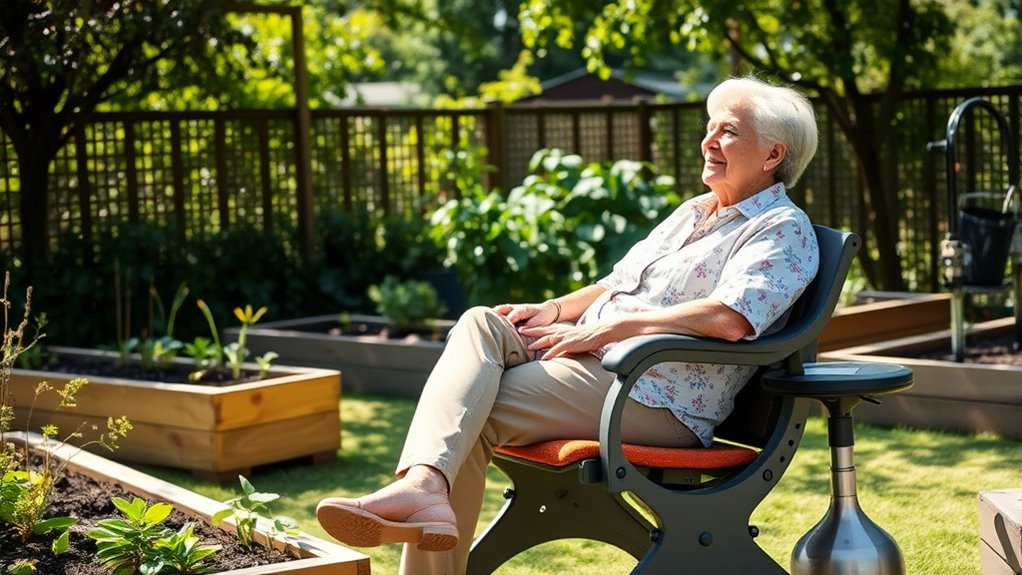
Creating comfortable seating and work areas is essential for preventing strain and making gardening sessions more enjoyable. When you have proper spots to sit and work, you reduce fatigue and protect your joints. Imagine feeling confident as you tend to your garden without pain or discomfort. Here are three ways to create inviting spaces:
- Choose sturdy, cushioned chairs with armrests for extra support, so you can relax and work longer.
- Set up a workbench at waist height to minimize bending and reach, reducing back strain.
- Use portable stools or kneelers that are lightweight and easy to move, giving you flexibility while working.
- Consider incorporating self-watering plant pots into your garden setup to ensure your plants receive consistent moisture with less effort, making tending to your garden even more comfortable.
These simple adjustments turn gardening into a comfortable, fulfilling activity you’ll look forward to every day.
Incorporating Raised Beds and Container Gardening
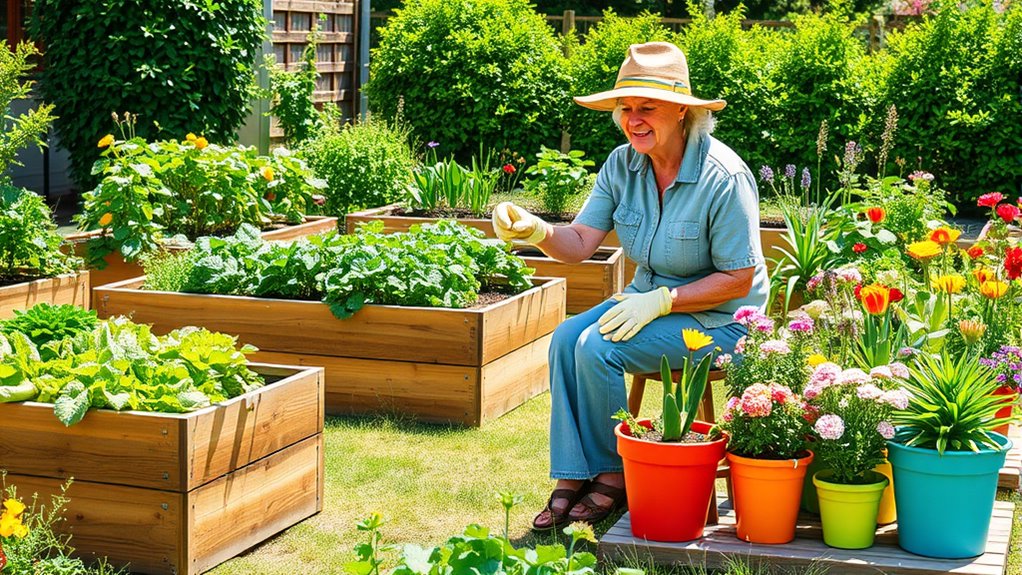
Incorporating raised beds and container gardening can considerably ease the physical demands of gardening by bringing plants to a more accessible height. This reduces the need to bend or kneel, lowering strain on your joints and back. Raised beds can be customized to your preferred height, making planting, watering, and harvesting more comfortable. Container gardening offers flexibility, allowing you to move plants to *ideal* light and protect them from pests. Here’s a quick comparison:
| Feature | Raised Beds | Container Gardening |
|---|---|---|
| Accessibility | Easier on joints | Portable, adaptable |
| Space | Larger areas | Smaller, flexible spaces |
| Maintenance | Less bending | Easy to reposition |
Both options help you enjoy gardening with less physical stress and more comfort. Proper storage of gardening tools and supplies] can also contribute to a safer and more efficient gardening experience.
Maintaining Balance and Stability While Gardening
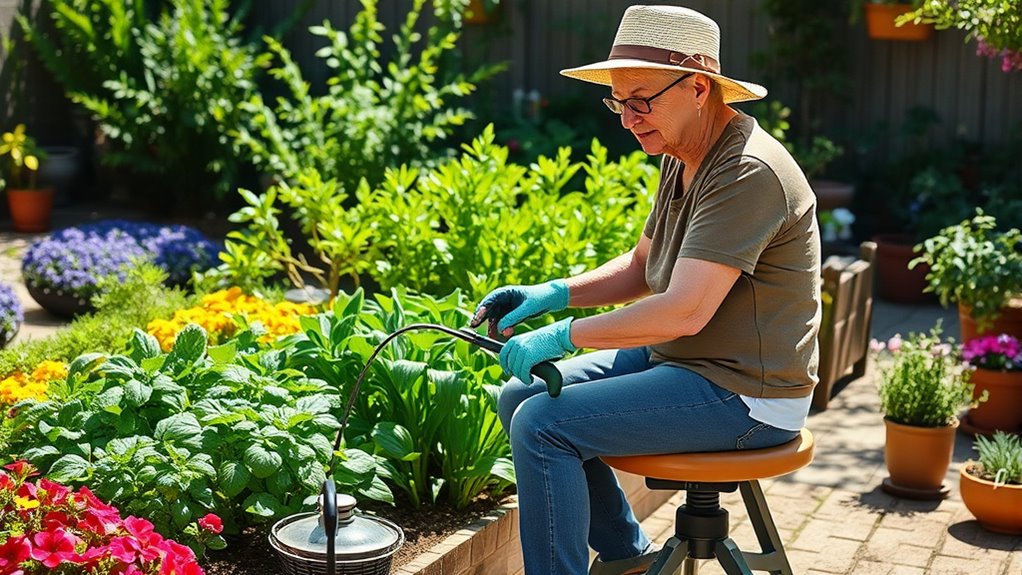
To stay balanced and stable while gardening, you need to use proper body mechanics, like keeping your back straight and bending at your hips and knees. Support tools, such as kneelers or gardening stools, can help prevent strain and maintain your stability. Remember to move carefully, using safe techniques to avoid slips or falls as you work.
Proper Body Mechanics
Maintaining proper body mechanics is essential for staying balanced and stable while gardening, preventing strain and injury. When you use correct techniques, you protect your joints and muscles, making gardening more comfortable and enjoyable. Focus on these key points:
- Keep your back straight when bending or reaching to avoid unnecessary strain.
- Bend at your hips and knees instead of your waist to reduce pressure on your spine.
- Engage your core muscles to support your movements and maintain stability.
Use of Support Tools
Using support tools can considerably enhance your balance and stability as you garden. Tools like garden stools, knee pads, and hand grips provide extra support, reducing strain on your joints and muscles. A sturdy garden chair or kneeling pad allows you to work comfortably at different heights, preventing awkward postures that could cause falls. Reach tools with long handles minimize the need to stretch or bend excessively, maintaining better balance. Installing support rails or handgrips along pathways offers steadying points as you move around your garden. Using these tools correctly helps you stay grounded and stable, reducing the risk of slips or falls. Incorporating support tools into your routine makes gardening safer, more comfortable, and more enjoyable.
Safe Movement Techniques
When moving around your garden, it’s important to keep your balance and stay stable to prevent falls or injuries. Focus on your posture and be mindful of your surroundings. Here are three tips to help you maintain safe movement:
- Use your legs, not your back, to lift and bend, reducing strain and keeping your center of gravity stable.
- Keep your feet shoulder-width apart to enhance balance during tasks like planting or weeding.
- Take slow, deliberate steps when changing positions, avoiding sudden movements that could cause slips or falls.
Practicing these techniques boosts your confidence and keeps you safe, so you can enjoy gardening without worry. Stay mindful, stay steady, and garden with joy!
Protecting Joints and Muscles During Gardening Tasks
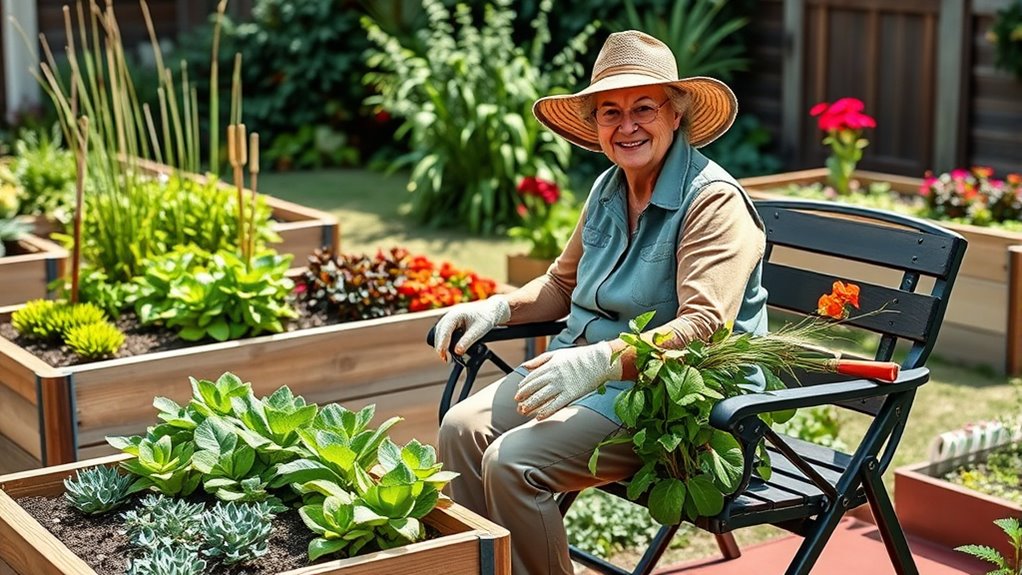
To protect your joints and muscles during gardening, it is vital to adopt proper techniques and use supportive tools. Keep your movements smooth and avoid twisting or overreaching, which can strain your joints. Use lightweight, ergonomically designed tools with padded handles to reduce pressure on your hands and wrists. When bending, hinge at your hips instead of your waist, and consider kneeling on a padded mat or using a garden seat to lessen knee stress. Take regular breaks to stretch and relax your muscles, preventing fatigue. Maintain good posture by standing tall and keeping your back straight. These simple strategies help reduce strain, prevent injuries, and make gardening more comfortable and enjoyable for years to come.
Developing a Routine to Reduce Fatigue
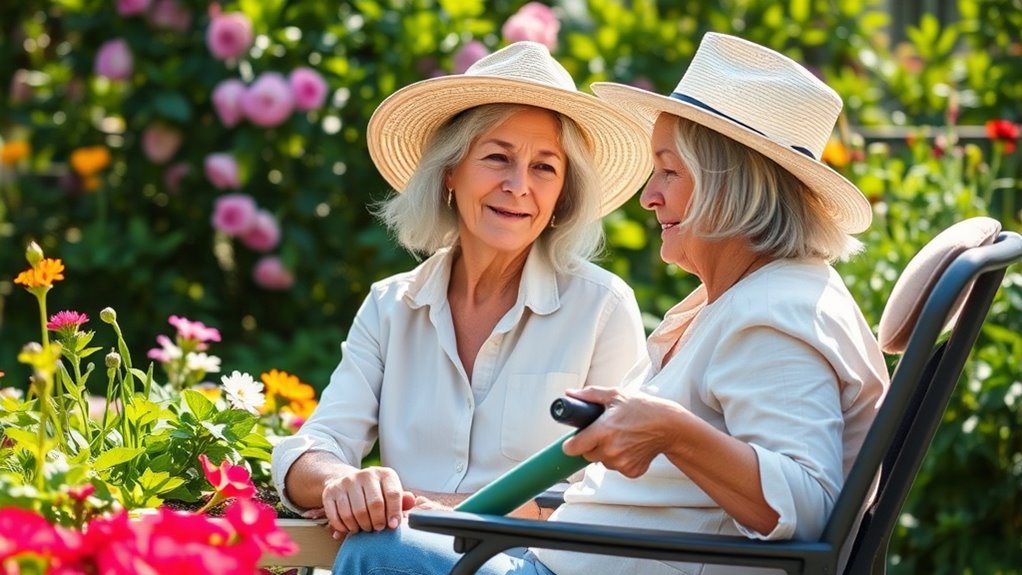
Establishing a consistent gardening routine can considerably reduce fatigue and increase your efficiency. When you set specific times and tasks, your body adapts, and you avoid overexertion. To help you stay energized, consider these strategies:
- Break tasks into smaller sessions—avoid long, exhausting periods of work.
- Prioritize essential chores—focus on what truly needs immediate attention.
- Include regular rest pauses—your body will thank you for the breaks and recovery time.
- Incorporating mixing techniques into your gardening activities can also enhance your experience and reduce strain by varying movements and approaches. Additionally, understanding how juice detox can impact your overall health might motivate you to incorporate nutritious habits into your routine, further supporting your energy levels.
Creating a predictable routine not only manages your workload but also boosts your confidence and enjoyment in gardening. Over time, these habits help you conserve energy, reduce strain, and maintain your love for gardening without feeling overwhelmed.
Tips for Sustaining Long-Term Ergonomic Gardening Habits
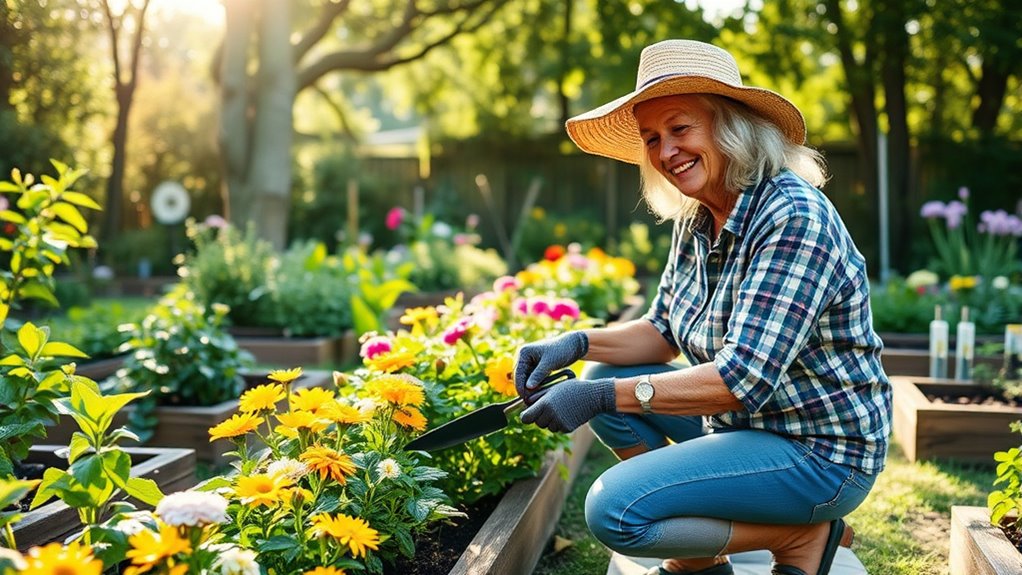
Building on your routine, maintaining long-term ergonomic habits requires ongoing commitment and mindful adjustments. Regularly evaluate your gardening posture and tools to guarantee they support your body’s needs. Incorporate small changes, like adjusting your kneeling pad height or switching tools to reduce strain. Stay aware of fatigue signals and take breaks before discomfort worsens. Keep your workspace organized to avoid unnecessary reaching or twisting. Practice stretching exercises tailored to gardening movements to improve flexibility and prevent injuries. Remember, ergonomic gardening is an active process that benefits from consistent attention and adaptation; making ergonomic practices a natural part of your gardening routine will help sustain your health and enjoyment over time. Also, considering Floating on Water techniques can provide additional ways to relax and recover after intensive gardening sessions. Embracing a mindset that values creative practice can inspire you to find innovative ways to modify your gardening habits and tools for better comfort. By staying attentive and adaptable, you’ll be able to garden comfortably and confidently for years to come.
Frequently Asked Questions
What Are the Best Ergonomic Gardening Tools for Seniors?
You want to find the best ergonomic gardening tools for seniors, and I recommend tools with lightweight designs, padded handles, and tools that reduce bending and strain. Look for tools with long handles to avoid kneeling or stooping, and consider ergonomic pruners and trowels with soft grips. These features make gardening easier, safer, and more comfortable, allowing you to enjoy your passion without unnecessary pain or fatigue.
How Can I Prevent Falls While Gardening?
To prevent falls while gardening, you should wear sturdy, non-slip shoes and keep pathways clear of obstacles. Use raised beds and ergonomic tools to reduce bending and stretching. Install handrails or supports where needed, and avoid working in wet or uneven areas. Take regular breaks to stay alert and hydrated. These steps help keep you safe, so you can enjoy gardening without worry.
Are There Specific Exercises to Improve Gardening Endurance?
You want to improve your gardening endurance, so try incorporating exercises like walking, cycling, and swimming to boost your stamina. Strengthen your core with planks and gentle yoga to support your back and improve flexibility. Leg lifts and squats can enhance leg strength, making prolonged gardening easier. Consistency is key—practice these exercises regularly, and you’ll notice increased endurance, making your gardening sessions more enjoyable and less tiring.
How Often Should I Take Breaks During Gardening?
They say “a stitch in time saves nine,” and that’s true for gardening too. You should take breaks every 20 to 30 minutes to rest your muscles and avoid fatigue. Listen to your body—if you feel tired or sore, pause sooner. Stretch, hydrate, and step back for a few minutes. Regular breaks keep you energized, prevent strain, and help you enjoy your gardening longer and healthier.
Can Ergonomic Gardening Techniques Help With Arthritis Pain?
Yes, ergonomic gardening techniques can help ease your arthritis pain. By using tools with cushioned, ergonomic handles and adjustable-height workstations, you reduce strain on your joints. You’ll find it easier to perform tasks without overexerting yourself, which can lessen inflammation and discomfort. Incorporating these techniques into your routine allows you to enjoy gardening longer, with less pain and fatigue, making your gardening experience more comfortable and enjoyable.
Conclusion
By embracing ergonomic gardening, you turn your garden into a sanctuary where comfort blooms alongside your plants. With the right tools, techniques, and mindset, you’ll nurture your green thumb without wearing yourself down. Think of your garden as a well-choreographed dance—each move smooth and effortless. Keep these habits in mind, and you’ll enjoy many seasons of gardening joy, feeling as resilient and vibrant as the flowers you tend to.
